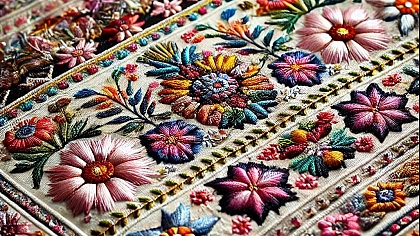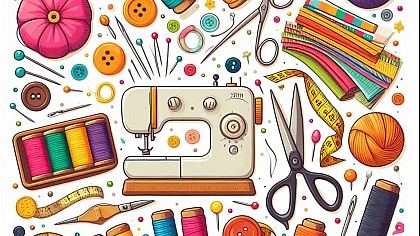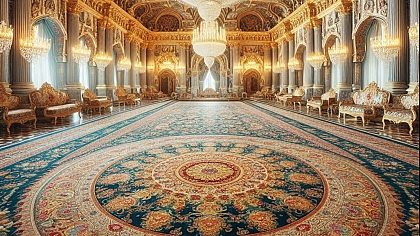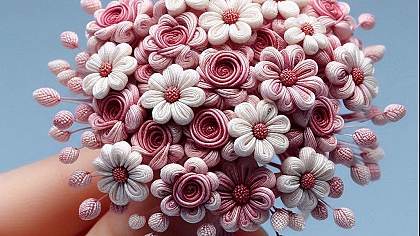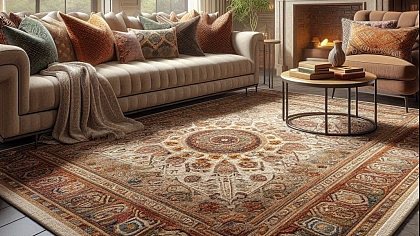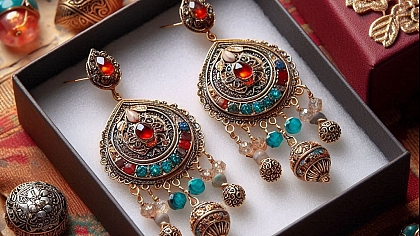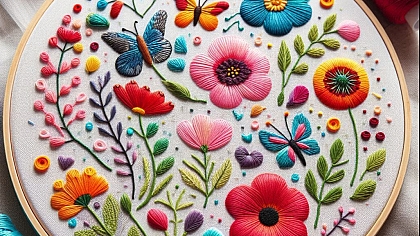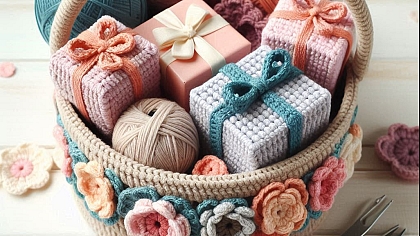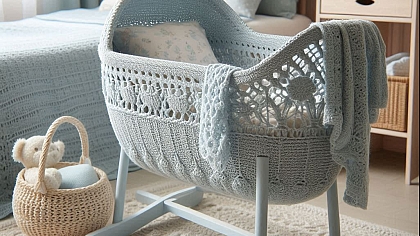
Knitting in the Round: Everything You Need to Know
Knitting in the round is a technique that offers endless possibilities for creating seamless garments, accessories, and decorative items. Unlike traditional flat knitting, where pieces are worked back and forth in rows and then seamed together, knitting in the round involves knitting continuously in a spiral, creating a tube of fabric. This method eliminates the need for seams, resulting in a smoother, more professional finish. Whether you're a seasoned knitter looking to expand your skills or a beginner eager to try something new, knitting in the round is a versatile and rewarding technique that opens up a world of creative potential.
Understanding the Basics of Knitting in the Round

At its core, knitting in the round is about working stitches in a continuous circle. Instead of turning your work at the end of each row, as you would with flat knitting, you keep knitting in the same direction, creating a seamless tube of fabric. This technique is ideal for projects like hats, socks, mittens, cowls, sleeves, and even sweaters. The beauty of knitting in the round lies in its simplicity and efficiency—there's no need to sew pieces together, and you can often avoid the dreaded purl stitch altogether if you're working in stockinette stitch.
The most common tools for knitting in the round are circular needles and double-pointed needles (DPNs). Circular needles consist of two short needle tips connected by a flexible cable. They come in various lengths, allowing you to knit anything from a small hat to a large blanket. Double-pointed needles are typically used for smaller projects like socks or the crowns of hats, where the circumference is too small for circular needles. These needles usually come in sets of five and allow you to knit in the round by dividing your stitches across three or four needles and using the fifth to knit.
When you begin knitting in the round, it's crucial to join your stitches without twisting them. A twisted join can result in a Mobius strip-like effect, where your project has an unintentional twist that cannot be undone without starting over. To avoid this, lay your stitches flat on the needles and ensure they all face the same direction before making the first stitch of your project.
Choosing the Right Needles and Yarn
Selecting the appropriate needles and yarn for your project is a critical step in knitting in the round. The size of your needles should match the thickness of your yarn and the gauge required for your pattern. Circular needles come in a wide range of lengths, from as short as 9 inches for small projects like cuffs and socks to 40 inches or longer for larger items like shawls or blankets. The length of your circular needle should match the circumference of the item you're knitting—using a needle that is too long can stretch your stitches and make knitting uncomfortable, while a needle that is too short can crowd your stitches and make it difficult to knit.
Double-pointed needles are usually used for smaller projects where circular needles would be too cumbersome. They come in various lengths, typically ranging from 4 to 8 inches. The choice of needle length depends on the number of stitches you're working with and your personal comfort. Some knitters prefer shorter needles for projects like socks, while others find longer needles easier to handle.
When it comes to yarn, the possibilities are endless. The choice of yarn depends on the type of project you're working on and the desired texture and drape of the finished item. For hats and mittens, a medium-weight yarn like worsted or aran is often ideal, providing warmth and durability. For socks, a finer yarn like fingering or sport weight is typically used, offering a snug fit and smooth texture. When knitting garments like sweaters in the round, consider the yarn's fiber content and how it will behave when worn. Wool is a popular choice for its warmth and elasticity, while cotton and linen offer breathability for warmer weather.
Mastering Tension and Gauge
Achieving the correct tension and gauge is essential for a successful project when knitting in the round. Gauge refers to the number of stitches and rows per inch, and it determines the size of your finished item. If your gauge is off, your project may turn out too large or too small. To ensure your gauge matches the pattern's requirements, it's important to knit a swatch in the round.
Knitting a gauge swatch in the round is different from swatching flat because your tension may vary when knitting in the round versus back and forth. To knit a swatch in the round, cast on the required number of stitches and knit across them as usual. Instead of turning your work, slide the stitches to the other end of the needle, carry the yarn loosely across the back of the work, and knit across again. This method mimics the continuous knitting in the round and gives you a more accurate gauge measurement.
Maintaining even tension is also crucial when knitting in the round. Uneven tension can result in stitches that are too tight or too loose, leading to an inconsistent fabric. If you're using double-pointed needles, the transition between needles can sometimes create loose stitches, known as "ladders." To prevent ladders, make sure to pull the first stitch on the new needle tightly and try to knit in a smooth, continuous motion.
Techniques for Joining in the Round

Joining your stitches in the round is a critical step that sets the foundation for your project. There are several methods for joining in the round, each with its own advantages. The simplest method involves casting on the required number of stitches, distributing them evenly on your needles, and knitting the first stitch of the round. However, this method can sometimes leave a small gap or jog where the join occurs.
To create a smoother join, some knitters prefer the "cast-on over two needles" method. In this technique, you cast on one extra stitch and then slip the first stitch you cast on to the left-hand needle. Knit these two stitches together, which closes the gap and creates a more seamless join.
Another popular method is the "long tail cast-on with a twist." After casting on the required number of stitches, twist the first stitch on the needle before joining it with the last stitch. This twist helps to tighten the join and prevent gaps.
For projects where a decorative edge is desired, the "provisional cast-on" can be used. This method involves using a scrap piece of yarn to cast on stitches, which are then joined in the round. The provisional cast-on is later removed, and the live stitches can be picked up and knitted in the opposite direction or bound off for a neat finish.
Working with Circular Needles
Circular needles are the most versatile tool for knitting in the round. They come in various lengths, making them suitable for a wide range of projects, from small accessories to large garments. The length of the circular needle should match the circumference of the item you're knitting. For example, a 16-inch circular needle is ideal for hats, while a 24- or 32-inch needle is better suited for sweaters or shawls.
One of the key advantages of circular needles is their ability to accommodate a large number of stitches. Unlike straight needles, which can become cumbersome when working with many stitches, circular needles allow the stitches to spread out along the cable, making knitting more comfortable and reducing strain on your hands and wrists.
When working with circular needles, it's important to ensure that your stitches are evenly distributed across the cable. If your stitches are too bunched up, they can become tight and difficult to knit. Conversely, if they are too spread out, they can stretch and affect the tension of your fabric.
The "magic loop" technique is a popular method for knitting small circumferences on long circular needles. To use this technique, you need a circular needle with a long, flexible cable, typically 32 inches or longer. The magic loop allows you to knit items like socks, mittens, or sleeves without using double-pointed needles. To start, you cast on your stitches and divide them in half. Then, pull the cable through the midpoint of the stitches, creating two loops on either side. As you knit, you slide the stitches along the cable, working one half of the stitches at a time. This method is particularly useful for knitters who prefer not to switch between different types of needles.
Working with Double-Pointed Needles
Double-pointed needles (DPNs) are the traditional tool for knitting in the round and are especially useful for small projects like socks, mittens, or the crowns of hats. DPNs typically come in sets of five and are available in various lengths and materials, including wood, metal, and plastic. The choice of material often comes down to personal preference, as each has its own advantages. Wooden needles are warm and have a bit of grip, which can be helpful for beginners, while metal needles are smooth and allow for faster knitting.
When working with DPNs, the stitches are divided evenly across three or four needles, with the remaining needle used to knit. This setup can feel awkward at first, but with practice, it becomes second nature. To avoid ladders, or loose stitches between the needles, it's important to maintain even tension when transitioning from one needle to the next. One way to do this is to knit the first few stitches on the new needle tightly, or to slightly overlap the stitches from the previous needle onto the next.
Another technique to avoid ladders is to periodically shift the stitches on the needles. For example, after completing a round, you can knit a few extra stitches onto the next needle before continuing. This method helps to distribute the tension more evenly and prevents any noticeable gaps from forming.
Advanced Techniques and Tips
Once you've mastered the basics of knitting in the round, there are several advanced techniques that can take your skills to the next level. One such technique is "two-at-a-time" knitting, where you knit two identical items simultaneously on one circular needle. This method is often used for socks, mittens, or sleeves and ensures that both items are identical in size and shape. To knit two
at a time, you need a long circular needle and two separate balls of yarn. Cast on the stitches for both items, alternating between the two, and then knit them in the round, switching between the two sets of stitches as you go.
Another advanced technique is "colorwork," where you knit with multiple colors of yarn to create intricate patterns and designs. Colorwork in the round can be challenging, as it often involves managing multiple strands of yarn and maintaining even tension. The "stranded" method is a popular colorwork technique, where the unused yarn is carried along the back of the work and "floated" over the stitches. To prevent the floats from becoming too tight, it's important to spread out the stitches on the needle as you work and to catch the floats every few stitches.
If you're interested in creating textured patterns, "cabling in the round" is another advanced technique worth exploring. Cabling involves crossing stitches over one another to create raised patterns on the fabric. When cabling in the round, it's important to pay attention to the placement of your cable needle and to ensure that the pattern remains consistent throughout the project. Cabling can be combined with other techniques, such as lace or colorwork, to create intricate and visually stunning designs.
For those who enjoy experimenting with different construction methods, "top-down" or "bottom-up" knitting in the round offers unique approaches to garment making. In top-down knitting, you start at the neckline and work your way down, allowing you to try on the garment as you go and make adjustments to the fit. Bottom-up knitting, on the other hand, starts at the hem and works up to the shoulders, often involving the use of steeks—reinforced areas of knitting that are later cut open to create armholes or a neckline.
Troubleshooting Common Issues
As with any knitting technique, knitting in the round can present challenges. One common issue is "twisting the join," where the stitches become twisted when joining in the round, resulting in a Mobius strip-like effect. To avoid this, always double-check that your stitches are aligned and facing the same direction before making the first stitch.
Another issue knitters may encounter is "laddering," where loose stitches form between the needles when using double-pointed needles or the magic loop method. To prevent ladders, ensure that you pull the yarn tightly when transitioning between needles, and consider shifting the stitches periodically to distribute the tension more evenly.
"Yarn management" can also be a challenge, especially when working with multiple colors or when knitting two items at a time. To keep your yarns from tangling, it's helpful to separate the balls of yarn and to hold the strands in different hands or positions as you work. For colorwork, consider using yarn bobbins or butterfly wraps to keep the strands organized.
If you notice that your gauge is inconsistent or that your stitches are uneven, it may be helpful to take a break and practice some basic exercises to improve your tension. Holding the yarn and needles in a way that feels comfortable and natural to you is key to maintaining even tension. Don't be afraid to experiment with different grips or knitting styles until you find what works best for you.
Embracing the Joy of Knitting in the Round

Knitting in the round is a versatile and rewarding technique that offers endless possibilities for creativity. Whether you're making a cozy hat, a pair of warm socks, or an intricate sweater, knitting in the round allows you to create seamless, professional-looking projects with ease. By mastering the basics and experimenting with advanced techniques, you can unlock new levels of skill and enjoyment in your knitting journey.
As with any craft, practice and patience are key to success. Don't be discouraged by mistakes or challenges—every project is an opportunity to learn and grow. With time and experience, you'll find that knitting in the round becomes second nature, and you'll be able to tackle even the most complex patterns with confidence.
So grab your circular needles or double-pointed needles, choose a beautiful yarn, and start your next project. The world of knitting in the round is waiting for you to explore, and the possibilities are truly endless.


